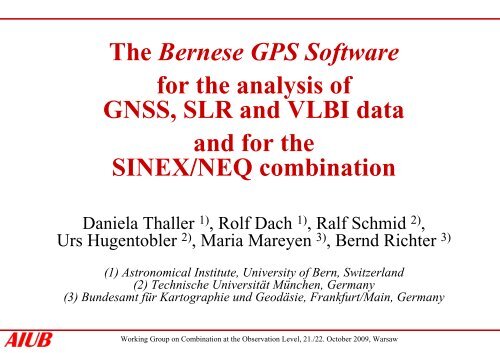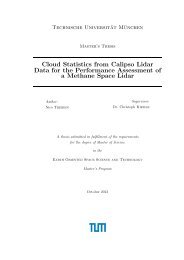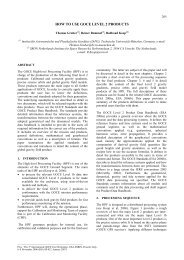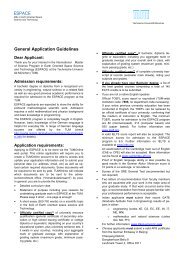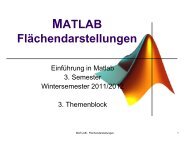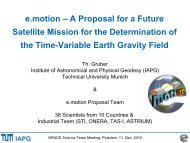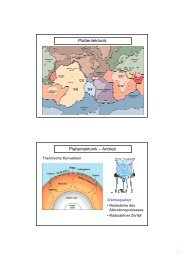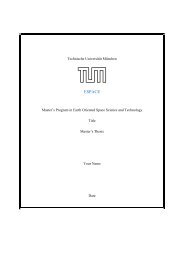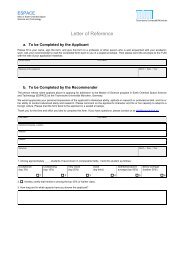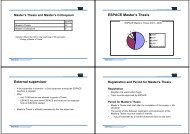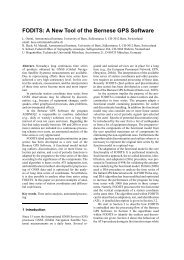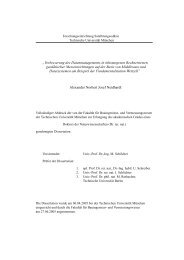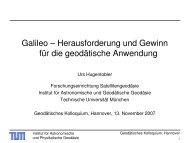Combination - Bernese GNSS Software
Combination - Bernese GNSS Software
Combination - Bernese GNSS Software
Create successful ePaper yourself
Turn your PDF publications into a flip-book with our unique Google optimized e-Paper software.
The <strong>Bernese</strong> GPS <strong>Software</strong><br />
for the analysis of<br />
<strong>GNSS</strong>, SLR and VLBI data<br />
and for the<br />
SINEX/NEQ combination<br />
Daniela Thaller 1) , Rolf Dach 1) , Ralf Schmid 2) ,<br />
Urs Hugentobler 2) , Maria Mareyen 3) , Bernd Richter 3)<br />
(1) Astronomical Institute, University of Bern, Switzerland<br />
(2) Technische Universität München, Germany<br />
(3) Bundesamt für Kartographie und Geodäsie, Frankfurt/Main, Germany<br />
Working Group on <strong>Combination</strong> at the Observation Level, 21./22. October 2009, Warsaw
1. Analysis of observation data<br />
a) <strong>GNSS</strong><br />
b) SLR<br />
c) VLBI<br />
Overview<br />
2. Combined <strong>GNSS</strong>+SLR analysis using satellite co-locations<br />
3. <strong>Combination</strong> using normal equations (intra- and inter-technique)<br />
Working Group on <strong>Combination</strong> at the Observation Level, 21./22. October 2009, Warsaw
Analysis of <strong>GNSS</strong> data<br />
Combined GPS+GLONASS analysis is possible with the <strong>Bernese</strong> GPS<br />
<strong>Software</strong> (BSW)<br />
Global analysis:<br />
→ CODE: IGS analysis center<br />
→ Final, rapid and ultra-rapid products<br />
→ Operational GPS+GLONASS contribution since May 2003<br />
Regional analysis:<br />
→ EUREF / SIRGAS contributions by most analysis centers<br />
Extension to multi-system <strong>GNSS</strong> analysis:<br />
→ Different systems (GPS, GLONASS, Galileo, ...)<br />
→ Different/individual observation types per <strong>GNSS</strong><br />
Working Group on <strong>Combination</strong> at the Observation Level, 21./22. October 2009, Warsaw
Analysis of SLR data<br />
SLR residual analysis w.r.t. given orbits / EOPs / station coordinates<br />
→ Contribution of AIUB to ILRS as associated analysis center:<br />
SLR residuals w.r.t. <strong>GNSS</strong> orbits<br />
Extension of the BSW to a full SLR analysis software package:<br />
→ SLR observations to geodetic satellites (mainly Lageos, Etalon)<br />
→ Estimation of SLR-specific parameters (orbits, range biases)<br />
→ ILRS modeling and data handling issues are implemented<br />
Intention: ILRS contribution of BKG generated with BSW<br />
Status: ILRS Benchmark solutions submitted<br />
→ validation process ongoing<br />
Working Group on <strong>Combination</strong> at the Observation Level, 21./22. October 2009, Warsaw
Analysis of VLBI data<br />
Extension of the BSW to a VLBI analysis software package<br />
Simplified VLBI analysis for limited set of VLBI sessions possible:<br />
→ Low degree of automation<br />
→ Simple clock model<br />
→ VLBI-specific effects like telescope deformations not yet implemented<br />
→ Starting from NGS Card Format<br />
Extensions needed to become a full VLBI analysis software package:<br />
→ Estimation of VLBI-specific parameters (e.g., quasar coordinates)<br />
→ Improvement of a priori models and parameterization (e.g., clocks,<br />
telescope deformation)<br />
→ Automation for analysing the entire history of VLBI sessions<br />
Working Group on <strong>Combination</strong> at the Observation Level, 21./22. October 2009, Warsaw
Analysis of VLBI data<br />
Comparison of VLBI-derived troposphere zenith delays with GPS-derived<br />
estimates:<br />
⇒ Remaining differences are not due to deficiencies in the software but<br />
due to unmodeled effects (e.g. uncalibrated radomes)<br />
Working Group on <strong>Combination</strong> at the Observation Level, 21./22. October 2009, Warsaw
Combined <strong>GNSS</strong>+SLR analysis<br />
Idea: Use satellite co-locations for connecting <strong>GNSS</strong> and SLR<br />
→ <strong>GNSS</strong> observations: GPS, GLONASS, (Galileo)<br />
→ SLR observations to <strong>GNSS</strong> satellites: 2/1 GPS, 3 GLONASS, ???<br />
1. Common parameters:<br />
-<br />
-<br />
-<br />
EOP<br />
Geocenter<br />
Station coordinates<br />
Already done for combination<br />
at NEQ level<br />
- Satellite orbit parameters (dynamical)<br />
2. Needed for connection:<br />
- Stations: Local ties<br />
- Satellite CoM: Vectors to microwave antenna and to laser retroreflectors<br />
Working Group on <strong>Combination</strong> at the Observation Level, 21./22. October 2009, Warsaw
3D vector difference [mm]<br />
90<br />
80<br />
70<br />
60<br />
50<br />
40<br />
30<br />
20<br />
10<br />
0<br />
Combined <strong>GNSS</strong>+SLR analysis: Advantages<br />
7090−YAR2<br />
7810−ZIMM<br />
7839−GRAZ<br />
7825−STR1<br />
7825−STR2<br />
7405−CONZ<br />
Comparison of estimated station coordinate differences and local ties<br />
7840−HERS<br />
7840−HERT<br />
8834−WTZR<br />
7105−GODE<br />
Working Group on <strong>Combination</strong> at the Observation Level, 21./22. October 2009, Warsaw<br />
7110−MONP<br />
7080−MDO1<br />
7941−MATE<br />
7941−MAT1<br />
7249−BJFS<br />
7501−HARB<br />
<strong>Combination</strong> <strong>GNSS</strong>+SLR<br />
AIUB single−technique solutions<br />
Number of SLR observations / 100<br />
→ Connection of techniques either on ground (LT) or in space (orbits)<br />
7501−HRAO<br />
7124−THTI<br />
7845−GRAS<br />
7841−POTS
3D vector difference [mm]<br />
90<br />
80<br />
70<br />
60<br />
50<br />
40<br />
30<br />
20<br />
10<br />
0<br />
Combined <strong>GNSS</strong>+SLR analysis: Advantages<br />
7090−YAR2<br />
7810−ZIMM<br />
7839−GRAZ<br />
7825−STR1<br />
7825−STR2<br />
7405−CONZ<br />
Comparison of estimated station coordinate differences and local ties<br />
7840−HERS<br />
7840−HERT<br />
8834−WTZR<br />
7105−GODE<br />
Working Group on <strong>Combination</strong> at the Observation Level, 21./22. October 2009, Warsaw<br />
7110−MONP<br />
7080−MDO1<br />
7941−MATE<br />
7941−MAT1<br />
7249−BJFS<br />
7501−HARB<br />
<strong>GNSS</strong> SAO fixed<br />
<strong>GNSS</strong> SAO estimated<br />
→ Allows transfer of scale information from SLR into <strong>GNSS</strong> network<br />
→ Estimation of SLR range biases (RGB) together with <strong>GNSS</strong> satellite antenna offsets<br />
(SAO) is possible<br />
7501−HRAO<br />
7124−THTI<br />
7845−GRAS<br />
7841−POTS
Range bias [mm]<br />
50<br />
40<br />
30<br />
20<br />
10<br />
0<br />
−10<br />
−20<br />
−30<br />
−40<br />
−50<br />
7090<br />
7405<br />
7810<br />
Combined <strong>GNSS</strong>+SLR analysis: Advantages<br />
Station−specific SLR range biases<br />
7839<br />
7825<br />
7406<br />
7832<br />
<strong>GNSS</strong> SAO fixed<br />
<strong>GNSS</strong> SAO estimated<br />
7237<br />
7840<br />
8834<br />
7105<br />
7110<br />
SAO Z−component [mm]<br />
−100<br />
−200<br />
−300<br />
Satellite−specific<br />
−400<br />
0 20 40 60 80 100 120 140<br />
Satellite number<br />
Working Group on <strong>Combination</strong> at the Observation Level, 21./22. October 2009, Warsaw<br />
300<br />
200<br />
100<br />
0<br />
SAO corrections for different RGB estimation<br />
GPS<br />
Station−specific<br />
System−specific<br />
GLONASS<br />
→ Allows transfer of scale information from SLR into <strong>GNSS</strong> network<br />
→ Estimation of SLR range biases (RGB) together with <strong>GNSS</strong> satellite antenna offsets<br />
(SAO) is possible<br />
→ Estimation of SAO consistently for GPS and GLONASS, and consistently with SLR scale
Common parameters:<br />
- EOP<br />
- Troposphere<br />
- Station coordinates<br />
Combined <strong>GNSS</strong>+VLBI analysis<br />
Advantages:<br />
- Full EOP information from VLBI transferred to <strong>GNSS</strong> (polar<br />
motion, UT/LOD, nutation)<br />
- Stabilization of coordinates by common troposphere estimates<br />
→ Benefit already shown for combination at NEQ level<br />
→ Not yet done for combination at the observation level<br />
Working Group on <strong>Combination</strong> at the Observation Level, 21./22. October 2009, Warsaw
<strong>Combination</strong> using NEQs<br />
General strategy in BSW concerning constraints:<br />
- NO constraints when storing individual NEQs<br />
- Application of constraints only if<br />
a) pre-eliminating parameters<br />
b) generating a solution (before inversion of NEQ)<br />
⇒ Full flexibility for computation of combined solutions<br />
3 equivalent applications within BSW:<br />
- <strong>GNSS</strong> 1-day analysis ⇒ <strong>GNSS</strong> n-day solution (e.g. 3-day)<br />
- Separate <strong>GNSS</strong>/SLR/VLBI analysis ⇒ Combined solution<br />
- SINEX input ⇒ Combined solution<br />
Working Group on <strong>Combination</strong> at the Observation Level, 21./22. October 2009, Warsaw
<strong>Combination</strong> using NEQs<br />
Working Group on <strong>Combination</strong> at the Observation Level, 21./22. October 2009, Warsaw
<strong>Combination</strong> using NEQs<br />
Working Group on <strong>Combination</strong> at the Observation Level, 21./22. October 2009, Warsaw
<strong>Combination</strong> using NEQs<br />
Working Group on <strong>Combination</strong> at the Observation Level, 21./22. October 2009, Warsaw


